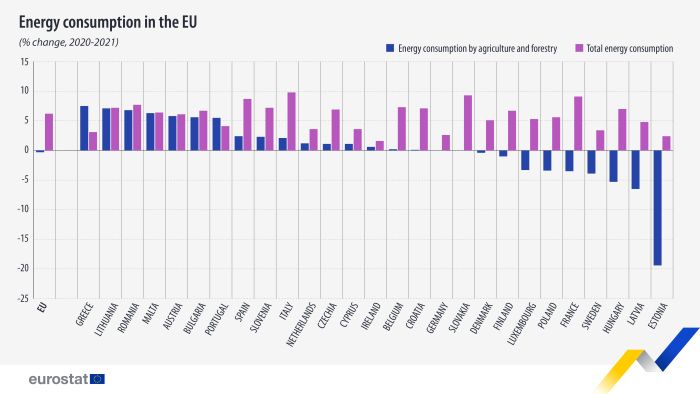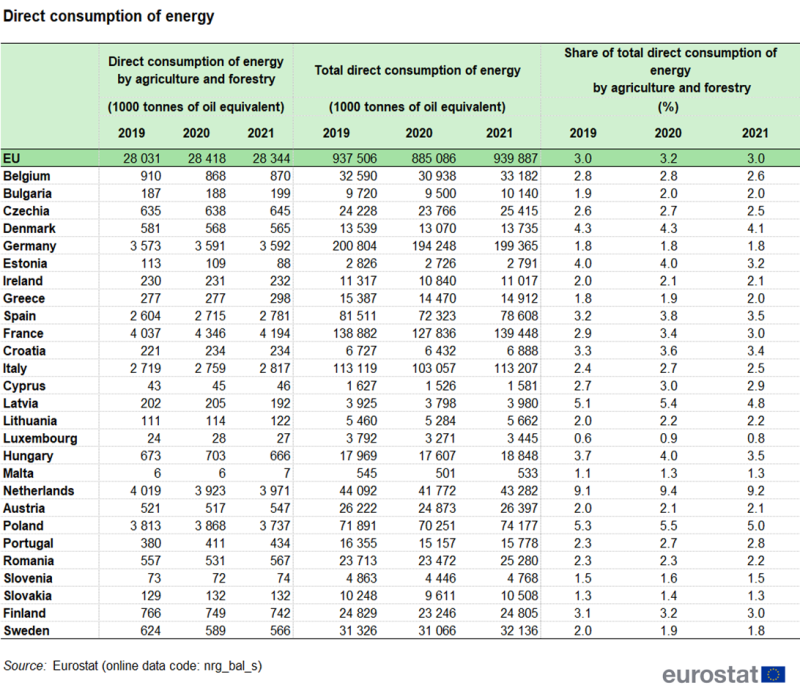Agri-environmental indicator - energy use
Data from August 2023
Planned article update: 29 November 2024
Highlights
Agriculture and forestry accounted for a 3.0 % share of the total direct energy consumption in the EU in 2021. At Member State level, the highest share was for the Netherlands (9.2 %).
Although total direct energy consumption for the EU in 2021 was 6.2 % higher than in 2020, consumption in agriculture and forestry held steady (down -0.3 %).
Between 2011 and 2021, apparent energy consumption per hectare of utilised agricultural area (UAA) declined most strongly in Greece (- 52.5 %).
This article presents statistics on the European Union's (EU) agri-environmental indicator energy use. It consists of an overview of data, complemented by the information needed to interpret these data. This article on energy use in the EU is part of a set of similar fact sheets, providing a comprehensive picture of the integration of environmental concerns into the common agricultural policy (CAP).
Energy is consumed directly by agriculture and forestry with the use of machinery (e.g. cultivation of fields with tractors) and the heating of livestock stables and greenhouses. Agriculture and forestry also uses energy indirectly, for the production of agrochemicals, farm machinery and buildings. Considerable amounts of natural gas are used for the production of inorganic nitrogen fertilisers. However, these indirect uses of energy are not covered by this indicator.
Full article
Analysis at EU and country level
The direct consumption of energy by agriculture and forestry in 2021 was little changed from that in 2020 (-0.3 %)
The EU's direct energy consumption (including the direct use of oil and petroleum, electricity, natural gas, renewables and solid fossil fuels) was around 940 million tonnes of oil equivalent in 2021. This was an increase of 54.8 million tonnes of oil equivalent on the amount used in 2020. However, within this total, the direct consumption of energy by agriculture and forestry was little changed, the decrease of 75 000 tonnes is equivalent to a slight decline of -0.3 % (see Table 1).
Currently, laws on energy efficiency are being revised to help the EU reach new ambitious climate goals set under the 2021 European Green Deal. This should not only contribute to reducing Europe's dependence on fossil fuel imports but could also reduce the CO2 emissions.
The rebound in the EU's total energy consumption in 2021 (+6.2 %) after the impact of COVID-19 restrictions in 2020, returned the EU's consumption level to slightly above that of 2019. As restrictions did not concern agriculture and forestry activities, as a key sector, the energy consumption in this sector remained relatively unchanged at the level of the EU as a whole.
Nevertheless, there were contrasting developments among Member States (see Figure 1). There were decreases in the direct use of energy by the agriculture and forestry sector of nine Member States in 2021, ranging from reductions equivalent to -0.4 % in Denmark to -19.4 % in Estonia. By contrast, there were increases of at least 5 % in Greece (+7.5 %), Lithuania (+7.1 %), Romania (+6.8 %), Malta (+6.3 %), Austria (+5.8 %) and Portugal (+5.5 %).
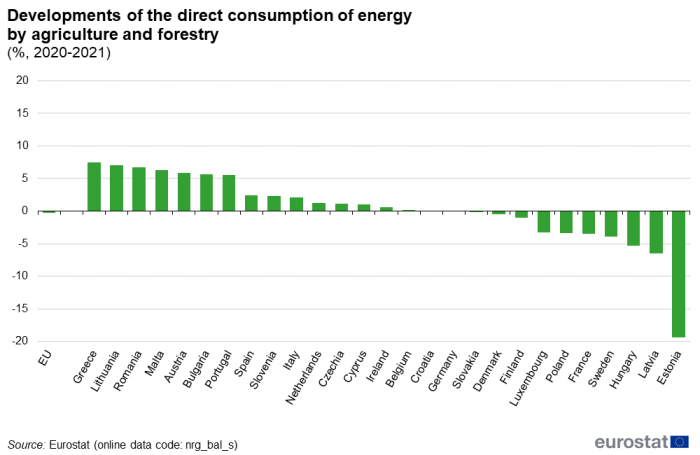
(%, 2020-2021)
Source: Eurostat (nrg_bal_s)
Agriculture and forestry accounted for 3.0 % of the total energy directly consumed in the EU in 2021.
The agricultural and forestry sector of the Netherlands accounted for the highest share of total direct consumption of energy among Member States (see Figure 2); the share of 9.2 % reflects the important role of greenhouses in the production of fruit, vegetables and horticultural plants. There were also relatively high shares in Poland (5.0 %) and Latvia (4.8 %) and Denmark (4.1 %).
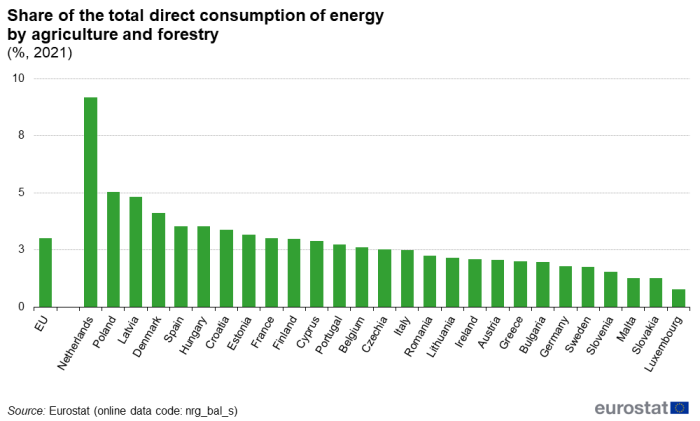
(%, 2021)
Source: Eurostat (nrg_bal_s)
Oil and petroleum products remained the main type of fuel for the direct consumption of energy in agriculture and forestry in 2021
In the EU, a majority (55.9 %) of the agriculture and forestry sector's total direct consumption of energy in 2021 was from oil and petroleum products (excluding biofuels). This was a significantly higher proportion than the economy as a whole (34.8 %).
Oil and petroleum products were the main fuel type used by the agriculture and forestry sector in most Member States. However, there were some notable exceptions. In the Netherlands, the direct consumption of energy from oil and petroleum products only accounted for 11.6 % of the total consumed directly by the agricultural and forestry sector in 2021, with a 52.2 % majority coming from natural gas and 22.4 % from electricity. In Greece, almost three-quarters (74.8 %) of the total direct consumption of energy by the agricultural and forestry sector was from electricity. In Sweden and Austria, renewables accounted for about one-third (35.6 % and 32.3 % respectively) of the total direct consumption of energy in the sector, with the share also above 20 % in Finland Germany, Czechia and Slovakia (see Figure 3).
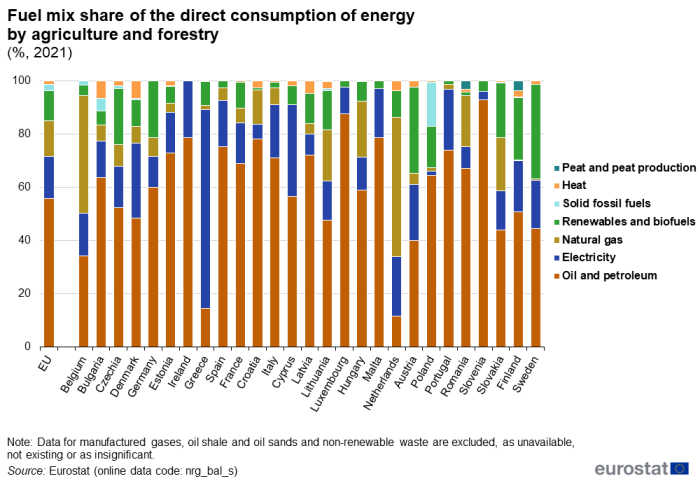
(%, 2021)
Source: Eurostat (nrg_bal_s)
Across the economy, the direct consumption of energy from renewables and biofuels more than doubled in the period between 2001 and 2021 and represented 11.8 % of the total direct consumption of energy in 2021. This was a pattern broadly followed within the agriculture and forestry sector, with a similar proportion (11.4 %) of the total direct consumption of energy coming from renewables and biofuels in 2021.
Energy consumption per hectare increased in the EU between 2011 and 2021
Total levels of energy consumption do not allow direct comparison between countries, as they differ in size. To compare trends across countries, a common denominator needs to be defined. Ideally there should be a strong link between the indicator and the denominator. A much-used denominator to assess agri-environmental indicators across countries is the utilised agricultural area (UAA).
The average direct consumption of energy by the EU's agriculture and forestry sector was 171 kilograms of oil equivalent per hectare (KgOE/ha) in 2021 – see Figure 4. The largescale production of fruit, vegetables and plants in greenhouses in the Netherlands helps explain the much higher average direct consumption of energy per hectare of UAA (2 192 KgOE/ha in 2021) than other Member States.
Among Member States, apparent energy consumption per hectare of UAA declined most strongly in the period between 2011 and 2021 in Greece (-52.5 %). By contrast, there were also notable rises of apparent energy consumption per hectare of UAA in Portugal (+24.9 %), Latvia (+25.2 %), Romania (+39.3 %), Hungary (+45.9 %) and Malta (+48.4 %).
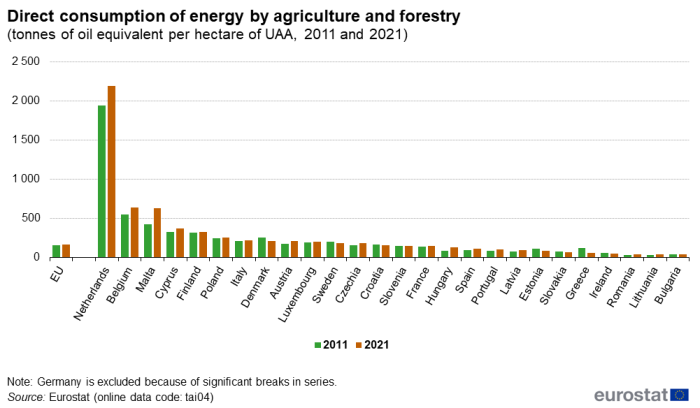
(tonnes of oil equivalent per hectare of UAA, 2011 and 2021)
Source: Eurostat (tai04)
Data sources
Indicator definition
The indicator relates to the direct use of energy (solid fuels, petroleum products, gas, electricity, renewables, heat) by agriculture per hectare (ha) of UAA. It assesses the trend of energy consumption, per ha and per fuel type and is measured by the following indicators:
Main indicator
Total direct energy use at farm level in kgoe per ha per year
Supporting indicator
Annual direct use of energy at farm level by fuel type (kgoe/ha)
Links with other indicators
This indicator has links to a number of other AEI indicators that describe developments related to agriculture and the environment.
Data used and methodology
For a detailed description of the data source see the methodology of:
Data for Germany on energy use in agriculture are starting to become available but was not included in longer-term comparisons (Figure 4) as there are significant breaks in series.
Data are expressed in tonnes of oil equivalents. Tonne(s) of oil equivalent, abbreviated as toe, is a normalised unit of energy. By convention it is equivalent to the approximate amount of energy that can be extracted from one tonne of crude oil. It is a standardised unit, assigned a net calorific value of 41 868 kilojoules/kg and may be used to compare the energy from different sources.
The main data source for this indicator are the joint energy questionnaires (Eurostat - OECD- UNECE). Energy indicators are compiled on the basis of the data collected under the standard collection cycles of the "Energy Statistics Unit". The relevant energy data collections are regulated since 2008 with the entry-into-force of the Regulation (EC) No 1099/2008 of the European Parliament and of the Council of 22 October 2008 on energy statistics. The energy statistics derived from the Joint Eurostat/OECD-IEA/UNECE questionnaires aim at presenting the full spectrum of the energy balances positions from supply through transformation to final energy consumption by sector and fuel type. Energy consumption by agriculture is of negligible importance to overall energy flows. Though the energy statistics are of high quality in general, the data on energy consumption by agriculture are of lower quality due to errors and incomplete data (e.g. breaks in time series for Germany, as explained above). No corrections have been made to the data as published in the Eurostat database. Energy consumption as presented here may therefore be underestimated due to missing data. Errors and missing data may also affect the trends in energy consumption over time and by fuel type.
In the Joint Questionnaires agriculture, forestry and fishing were combined in one category until 2004. From 2004 the questionnaires have distinguished fishing separately from agriculture/forestry. In 2014, 20 Member States and 5 other countries delivered separate data on fishing. For remaining countries it is possible that energy consumption by fishing is still included in the category agriculture/forestry. The share of fishing in the sum of energy consumption by agriculture, forestry and fishing is often not negligible. The shares in 2014 were: Iceland 85 %, Norway 56 %, Portugal 21 %, Denmark 14 %, Croatia 12 %, Greece 9 %, France and Italy 7 %, Cyprus 6 %, and in Latvia, the Netherlands, Finland and Sweden 5 %. The share of fishing was below 5 % in Bulgaria, Czechia, Estonia, Spain, Lithuania, Hungary, Malta, Poland, and Romania.
Energy consumption by agriculture may be overestimated in countries with a significant forestry sector. From Denmark data have been received from the environmental accounts for energy use by agriculture, forestry and fishing separately and from Norway from the energy accounts. Data from these data sources show that the share of forestry in energy consumption by agriculture and forestry combined is around 1 % in Denmark (1990-2008) and the share of forestry in energy consumption by agriculture and forestry combined is of minor significance in Norway (ca. 5 % in 2007). For other countries data on the use of energy by forestry is not available and an estimate for the share of energy consumption in energy consumption by agriculture and forestry cannot be provided. In most countries however the energy consumption by forestry is expected to be of minor significance.
For the indicator per ha, land use data from crop statistics are used. These data are annually available. Agriculture is highly heterogeneous in the EU; to target policies data would be needed by farm-type and region. This would also allow using different denominators for different farm types, for example for livestock farms a more appropriate denominator could be the number of animals.
Context
Energy is consumed directly by agriculture with the use of machinery (e.g. cultivation of fields with tractors) and the heating of livestock stables and greenhouses. Agriculture also uses energy indirectly, for the production of agrochemicals, farm machinery and buildings. Considerable amounts of natural gas are used for the production of inorganic nitrogen fertilisers. The indicator currently only includes direct energy consumption.
Policy relevance and context
Following what was first set out in Europe 2020 (COM (2007) 1 final), the Energy Efficiency Directive (2012/27/EU) included a target of reducing, by 2020, energy consumption in the EU by 20 % compared with projections. In December 2018, an amendment to this directive (EU 2018/2002) established an increased target of 32.5 % by 2030. With the European Green Deal, the Commission proposed a set of measures aiming to turn Europe into the first climate neutral continent by 2050. This will require further improvements in energy efficiency, namely a further increased target of 36-39 % by 2030.
To achieve these targets, EU countries are required to set their own indicative national energy efficiency targets. The Commission estimated, in the 2019 assessment of progress (COM(2020) 326), that the 2020 target was unlikely to be met without the impact of external factors, highlighting a need to step up efforts.
To assess energy efficiency, data on energy consumption would need to be linked to outputs produced. The FP7 research project "State of the Art on Energy Efficiency in Agriculture" produced country data on energy consumption in different agro-production sectors in European countries. Scenario building showed that the specific energy input (direct and indirect energy) in crop production differed between countries for the same crop. For example, specific energy input in wheat production was estimated to be twice as high in Portugal as in the Netherlands.
The structure of direct and indirect energy use may reflect the potential for energy savings. The figures presented for agriculture in this fact sheet relate only to direct energy use and are therefore underestimations of the total energy use. Agriculture uses also energy indirectly through the use of fertilisers, pesticides, animal feed and agricultural machinery (which are produced using large amounts of energy). Data on indirect use of energy by agriculture are not available at EU-level. The "State of the Art on Energy Efficiency in Agriculture" project showed for example that indirect energy use was higher than the direct energy use in most countries for wheat production, while the direct energy use was over 90 % for sunflower production in Portugal and for cotton production in Greece. With this kind of information it is possible to better target energy savings.
The structure of direct and indirect energy use may reflect the potential for energy savings.
Agri-environmental context
The use of machinery and mineral fertilisers has made it possible to increase agricultural productivity and improve yields and the supply of food. However, agriculture, as an energy user, contributes to the depletion of non-renewable energy resources and to global warming through energy-related emissions (like CO2 emissions from fossil fuel combustion). To facilitate influencing energy consumption levels through policy measures, the factors which influence energy levels should be understood. The indicator could be improved if data would be available by farm-type and region.
Agriculture is also an energy producer through renewable resources such as biogas, biomass, wind and solar energy. The EU finances, through the CAP, investments in improving the energy efficiency in agriculture and food processing, as well as in renewable energy production on farms and in rural areas.
Direct access to
- Energy data - 2020 edition
- Shedding light on energy in the EU — A guided tour of energy statistics (digital publication) — 2020 edition
- Energy, transport and environment indicators - 2020 edition
- Agriculture, forestry and fishery statistics - 2020 edition
- Energy (nrg), see
- Energy Statistics - quantities (nrg_quant)
- Energy Statistics - quantities, annual data (nrg_quanta)
- Energy balances (nrg_bal)
- Simplified energy balances (nrg_bal_s)
- Energy balances (nrg_bal)
- Energy Statistics - quantities, annual data (nrg_quanta)
- Energy Statistics - quantities (nrg_quant)
- Agriculture, see
- Agricultural production (apro)
- Crops (apro_crop)
- Crop product (apro_cp)
- Crop production in EU standard humidity (from 200 onwards)) (apro_cpsh)
- Crop production in EU standard humidity (apro_cpsh1)
- Crop production in EU standard humidity (from 200 onwards)) (apro_cpsh)
- Crop product (apro_cp)
- Crops (apro_crop)
- Agricultural production (apro)
- Cross cutting topics, see
- Agri-environmental indicators
- Final energy consumption by agriculture/forestry per hectare of utilised agricultural area (tai04)
- Agri-environmental indicators
- Commission Communication COM(2006) 508 final - Development of agri-environmental indicators for monitoring the integration of environmental concerns into the common agricultural policy
- Commission Staff working document accompanying COM(2006)508 final
